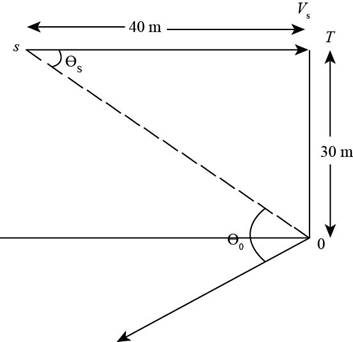
Concept explainers
(a)
The frequency heard by the passengers in the car.
(a)
Answer to Problem 17.71CP
The frequency heard by the passengers in the car is
Explanation of Solution
Given info: The speed of the train is
Consider the following figure.

Figure (1)
In right angle triangle
Substitute
The value of the
In triangle
Substitute
The value of the
The expression for the frequency heard by the passengers in the car is,
Here,
Substitute
Conclusion:
Therefore the frequency heard by the passengers in the car is
(b)
The range of frequencies heard by the passenger in the car.
(b)
Answer to Problem 17.71CP
The range of frequencies heard by the passenger in the car is
Explanation of Solution
Given info: The speed of the train is
Since the observer and source are moving away from each other so the value of the angles becomes equal to zero.
The expression for the frequency heard by the passengers in the car is,
For the case when the train is arrived:
Substitute
For the case when train is arriving:
Substitute
Conclusion:
Therefore the range of frequencies heard by the passenger in the car is
(c)
The frequency heard by the passengers in the car.
(c)
Answer to Problem 17.71CP
The frequency heard by the passengers in the car is
Explanation of Solution
Given info: The speed of the train is
The expression for the frequency heard by the passengers in the car is,
Substitute
Conclusion:
Therefore the frequency heard by the passengers in the car is
Want to see more full solutions like this?
Chapter 17 Solutions
EBK PHYSICS FOR SCIENTISTS AND ENGINEER
- pls help on thesearrow_forward20. Two small conducting spheres are placed on top of insulating pads. The 3.7 × 10-10 C sphere is fixed whie the 3.0 × 107 C sphere, initially at rest, is free to move. The mass of each sphere is 0.09 kg. If the spheres are initially 0.10 m apart, how fast will the sphere be moving when they are 1.5 m apart?arrow_forwardpls help on allarrow_forward
- 19. Mount Everest, Earth's highest mountain above sea level, has a peak of 8849 m above sea level. Assume that sea level defines the height of Earth's surface. (re = 6.38 × 106 m, ME = 5.98 × 1024 kg, G = 6.67 × 10 -11 Nm²/kg²) a. Calculate the strength of Earth's gravitational field at a point at the peak of Mount Everest. b. What is the ratio of the strength of Earth's gravitational field at a point 644416m below the surface of the Earth to a point at the top of Mount Everest? C. A tourist watching the sunrise on top of Mount Everest observes a satellite orbiting Earth at an altitude 3580 km above his position. Determine the speed of the satellite.arrow_forwardpls help on allarrow_forwardpls help on allarrow_forward
- 6. As the distance between two charges decreases, the magnitude of the electric potential energy of the two-charge system: a) Always increases b) Always decreases c) Increases if the charges have the same sign, decreases if they have the opposite signs d) Increases if the charges have the opposite sign, decreases if they have the same sign 7. To analyze the motion of an elastic collision between two charged particles we use conservation of & a) Energy, Velocity b) Momentum, Force c) Mass, Momentum d) Energy, Momentum e) Kinetic Energy, Potential Energyarrow_forwardpls help on all asked questions kindlyarrow_forwardpls help on all asked questions kindlyarrow_forward
 Principles of Physics: A Calculus-Based TextPhysicsISBN:9781133104261Author:Raymond A. Serway, John W. JewettPublisher:Cengage Learning
Principles of Physics: A Calculus-Based TextPhysicsISBN:9781133104261Author:Raymond A. Serway, John W. JewettPublisher:Cengage Learning University Physics Volume 1PhysicsISBN:9781938168277Author:William Moebs, Samuel J. Ling, Jeff SannyPublisher:OpenStax - Rice University
University Physics Volume 1PhysicsISBN:9781938168277Author:William Moebs, Samuel J. Ling, Jeff SannyPublisher:OpenStax - Rice University
 Physics for Scientists and Engineers: Foundations...PhysicsISBN:9781133939146Author:Katz, Debora M.Publisher:Cengage Learning
Physics for Scientists and Engineers: Foundations...PhysicsISBN:9781133939146Author:Katz, Debora M.Publisher:Cengage Learning Physics for Scientists and Engineers with Modern ...PhysicsISBN:9781337553292Author:Raymond A. Serway, John W. JewettPublisher:Cengage Learning
Physics for Scientists and Engineers with Modern ...PhysicsISBN:9781337553292Author:Raymond A. Serway, John W. JewettPublisher:Cengage Learning Physics for Scientists and EngineersPhysicsISBN:9781337553278Author:Raymond A. Serway, John W. JewettPublisher:Cengage Learning
Physics for Scientists and EngineersPhysicsISBN:9781337553278Author:Raymond A. Serway, John W. JewettPublisher:Cengage Learning





